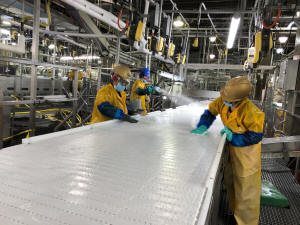As U.S. pork plant speeds up slaughtering, workers report more injuries
 Send a link to a friend
Send a link to a friend
 [February 19, 2021]
By Tom Polansek and P.J. Huffstutter [February 19, 2021]
By Tom Polansek and P.J. Huffstutter
CHICAGO (Reuters) - One of America's
leading pig slaughterhouses is running faster than ever as meatpackers
hustle to keep pork in grocery stores during the COVID-19 pandemic.
Plant worker Hector Ixquier says it's time to slow down.
Ixquier said he sought medical treatment in January for tendons he
strained in his right arm while draining blood from pigs in a Seaboard
Foods pork plant in Guymon, Oklahoma.
The 30-year-old immigrant from Guatemala said he requested a transfer to
the position piercing jugular veins about five months ago, after an
increase in slaughtering speeds made it too tiring to do his previous
job: wrestling chains around pigs' hind legs before they are killed.
His new job is also physically taxing, and a doctor recommended rest and
avoiding certain tasks at work, Ixquier said in an interview. "I'm
thankful for the opportunity,” he said of the new gig, “but it's still
too fast."
Seaboard, the second-biggest U.S. pig producer after Smithfield Foods,
sped up its Guymon operations last year after the U.S. government
removed limits on pork plant line speeds in late 2019. It was the first
plant to operate under the new rule, which was intended to allow
processors to produce meat more quickly.

But some workers, like Ixquier, say they have suffered physically as a
result. Seaboard now requires employees to slaughter between about 1,230
and 1,300 hogs per hour, two plant workers who are also union stewards
told Reuters. That compares to under 1,100 an hour in 2019, said one of
the workers, Jose Quinonez.
Workers and their advocates say the rule change is part of a series of
measures finalized by former President Donald Trump’s administration
that jeopardize employee safety, including exempting dozens of poultry
plants from slower line speeds and re-opening plants battling COVID-19.
The changes, and prevalence of COVID-19 at slaughterhouses, have made it
harder to keep workers in their jobs at a time when U.S. companies are
trying to build up meat supplies.
Seaboard, which didn’t respond to questions about Ixquier, said employee
health is a top priority. The company, a subsidiary of Kansas-based
Seaboard Corp, works to improve processes and equipment and hires
additional employees to help ensure each worker's load is manageable and
safe, said Seaboard spokesman David Eaheart.
Eaheart added that the rule relaxing pork line speed limits improves
Seaboard's ability to adjust operations based on demand. Seaboard aims
to average 1,200 pigs per hour under normal conditions, but has adjusted
speeds as the pandemic has reduced staffing, he said. The company needs
to examine how the plant will work under non-COVID-19 conditions to
“truly understand” how the change affects it business, Eaheart said.
Under the new rule, pork plants can slaughter as fast as they want, as
long as they prevent fecal contamination and minimize bacteria.
Previously, the government-imposed limit was 1,106 pigs per hour.
President Joe Biden's administration, which pledges to prioritize worker
safety, withdrew a Trump era proposal to allow all poultry plants to
operate faster. But reversing the pork rule would be trickier, lawyers
said, because it is already in effect.
The 2019 elimination of pork line speeds by the U.S. Department of
Agriculture (USDA) was part of the New Swine Inspection System, which
also lets pork plants use some company inspectors instead of USDA ones.
The USDA said that it isn’t considering a rollback of its elimination of
pork line speeds. But it said the agency is “closely examining” how the
new pork inspection system was developed.
The White House did not respond to questions about line speeds.
Slaughterhouse closures due to outbreaks last spring, record-large U.S.
pork exports in 2020 and consumers stockpiling food during the pandemic
have run down inventories in commercial freezers across the United
States. Total U.S. pork inventories in cold storage were at a
ten-and-a-half year low at the end of December.
INJURY INCREASE
Guymon, a city of about 11,000 people, is dominated by the Seaboard pork
plant. Last March, it became the first slaughterhouse to operate under
the new rule, according to USDA documents. Prior to the rule change, six
other major U.S. pork plants had surpassed the previous slaughter speed
limits with special USDA permission, the agency documents show. The USDA
told Reuters that the slaughterhouses had demonstrated they were capable
of producing safe pork while operating at faster speeds.
[to top of second column]
|

Workers disinfect a conveyor belt, part of the measures installed to
help slow the spread of coronavirus disease (COVID-19) at the
Seaboard Foods pork processing plant in Guymon, Oklahoma, U.S. May
17, 2020. Seaboard Foods/Handout via REUTERS

Seaboard’s plans to increase line speeds predated the coronavirus
pandemic. Its decision to go ahead coincided with the mass spread of
COVID-19 in the United States. Hundreds of the slaughterhouse's
2,700 employees were infected.
Seaboard spokesman Eaheart said the company wanted to operate faster
to reduce the number of six-day work weeks for employees and give
them more rest. However, lower staffing levels due to the pandemic
forced the company at times to slow line speeds and to require
employees to work on Saturdays, he said.
The local United Food and Commercial Workers International union
representing Guymon workers said it has seen a correlation between
speeding up the lines and more workers going to the plant's nurse's
station. It declined to provide figures.
Company data show an uptick in injuries. The Seaboard plant in 2020
reported five lacerations on the slaughtering floor that required
paid medical treatment outside of the plant such as stitches, a
three-year high, according to the company. That compares to one
laceration claim in 2019, zero in 2018, and five in 2017.
The plant also saw an increase in less-serious cuts that did not
require outside medical attention, the company said. The number of
these incidents, which can include minor cuts treated with adhesive
bandages, jumped to 19 last year from 10 in each of the prior two
years.
Seaboard says its overall injury rate is well below the Bureau of
Labor Statistics' industry standard for animal slaughtering and
processing.
Nationwide, inspections of serious incidents at meat plants rose
last year. The Occupational Safety and Health Administration (OSHA)
conducted 27 inspections at non-poultry meat plants in 2020 due to
either a "fatality" or a "catastrophe," up from one in 2017, three
in 2018 and five in 2019, OSHA data shows.

The UFCW in 2019 filed a lawsuit against the USDA in Minnesota
federal court seeking to reverse the pork speed rule change,
alleging it is unsafe for workers. The USDA said in court filings
that the union did not show a direct link between workers’ alleged
injuries and the rule change. The lawsuit is ongoing.
‘PRODUCTION HAS TO GO ON’
More pork plants are planning to opt into the system, which
eliminates speed limits.
Meat giant Tyson Foods Inc notified the USDA it intends over the
next several months to resume implementation of the system at plants
in Madison, Nebraska, and Perry, Iowa. Tyson had paused plans to opt
in last year because of the pandemic, spokeswoman Liz Croston said.
Tyson is focused on modernizing inspections, not line speeds, she
said, and does not anticipate “immediate significant change” to its
slaughter capacities.
At Seaboard’s Guymon plant, UFCW steward Quinonez told Reuters he
transferred to a job slicing skin off hog heads last year. The
faster line speeds had left him unable to keep up with his former
gig: scraping hair and skin off tongues. A 13-year employee at the
plant, he said the speed increase worsened pain in his hands and
shoulders that he’d experienced in his former job. He now reports
back problems as well.
If Seaboard needs to pause production because of a mechanical
problem or other glitch, the plant later runs even faster to make up
for the halt, he said. "At the end of the day, the production has to
go on - no matter what," Quinonez said.
(Additional reporting by Christopher Walljasper in Chicago.; Editing
by Caroline Stauffer and Cassell Bryan-Low)
[© 2021 Thomson Reuters. All rights
reserved.] Copyright 2021 Reuters. All rights reserved. This material may not be published,
broadcast, rewritten or redistributed.
Thompson Reuters is solely responsible for this content. |